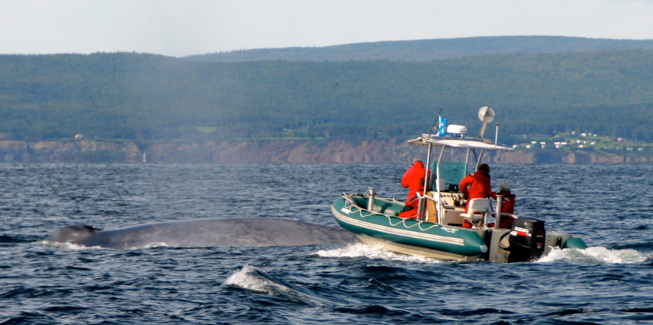Singing the Blues: The Mystery of B105
Published
Categories
Author
Blog Post
Guest blog written by 2017 Environmental Visual Communication student Viridiana Jimenez
For millions of years, the underwater world was a stage for the sounds of marine creatures, big and small. However, this symphony eventually became masked by the sounds of a creature new to the oceans: humans. Whales use sound as one of their primary senses to navigate, forage and communicate. What happens when they can no longer hear or be heard?
The many different songs of the ocean became known to Science in a surprising way. The Cold War of the latter half of the 20th century and its arms race between the USA and Russia led to great leaps of scientific progress, from the reaches of outer space to the bottom of the ocean. In an effort to detect and deflect Russian submarines, the US Navy deployed a hydrophone array called a “Sound Surveillance System” (SOSUS). This resembled a “string of pearls” of sorts, where the pearls were underwater microphones placed along the seabed that would record the sounds of enemy activity from across the Atlantic Ocean. At a time when the oceans were believed to be devoid of sound, as the title of Cousteau’s famous documentary “The Silent World” alluded, it must have been perplexing to discover the variety of natural sounds that were recorded during this time. One of the more profound sound discoveries was undoubtedly the low-pitched rumbles and practically inaudible howls repeated with the precision of Swiss clockwork—the songs of blue whales.

Our knowledge of these mysterious giants at that time was virtually nonexistent. Among the scientists who started to venture out to sea, driven by the desire to study those elusive creatures, was Richard Sears. In 1979, this Massachusetts-born Franco-American pioneer launched his first small inflatable boat off a beach on the North Shore of Quebec onto the cold waters of the Gulf of St Lawrence. He was drawn by the sight of tall spouts on the horizon, and soon the Mingan Island Cetacean Study (MICS) was born. Sears was the first to establish that individual blue whales could be individually identified thanks to the mottled pigmentation of their skin. In the forty years that followed that fateful trip, Sears would come to identify and recognise hundreds of individual blue whales in the North Atlantic.
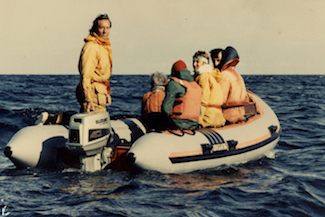
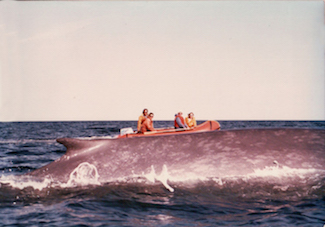
MICS’ research initially focused mainly on boat-based surveys and observations. The discovery that individual whales could be identified has empowered a network of whale-watchers, scientists, sailors and citizens to share their blue whale pictures with MICS. They have become the curators of the North Atlantic blue whale catalogue.
In the 1980s, despite the severe decline in their population due to commercial whaling, blue whales were relatively abundant in the St Lawrence. By 1984, Richard Sears had identified well over a hundred blue whales and given them all individual codes. Recurring whales were given names in order to make it easier to remember them out at sea. B105, who would later come to be known as “Invasor”, was identified for the first time that year. But it would take 30 years for MICS to see this whale again.

In the 1990s, at the end of the Cold War, the US Navy decided to share its acoustic data with a select few scientists. Christopher W. Clark was brought in by the US Navy to analyse the sounds recorded by SOSUS. As a young bioacoustics engineer, Clark’s profession was to listen to—and study—the sounds and songs of life in the air, on land, and in the oceans. It was the perfect opportunity to test a theory he had heard years before from Roger Payne, a fellow bioacoustician—that blue whale sounds could be heard across entire oceans.
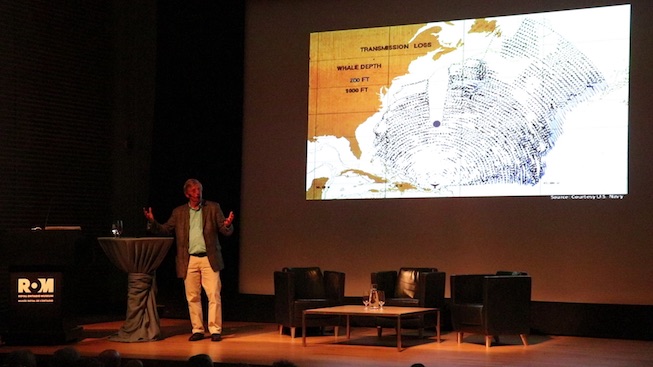
Clark not only figured out how to listen to the infrasonic blue whale sounds, but also calculated that these sounds could be heard from over 3000 kilometers away through a specific underwater sound channel called the Sound Fixing And Ranging channel (SOFAR), or deep sound channel (DSC). This discovery changed the way we perceive scale and population structure in whales and prompted questions such as: Can blue whales be considered to be “far away” from each other or even separate populations if they can communicate across an entire ocean basin? What does this mean in terms of their lifestyle and habits? How can we hope to effectively conserve this species through national legislation when their reach stretches far beyond the artificial borders at the human scale?
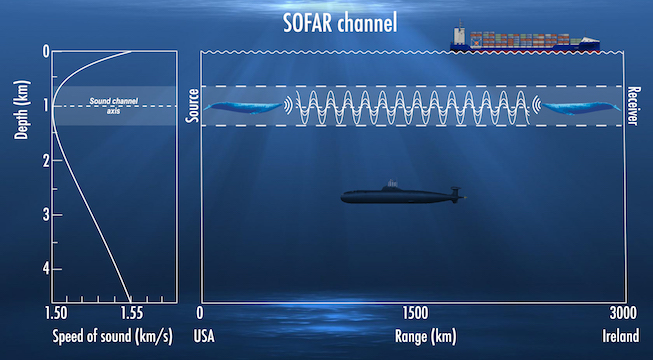
The effects of noise pollution on whales are well-documented. As such, noise pollution has been an increasing concern among whale scientists. This pervasive phenomenon disrupts foraging, interferes with communication between whales, and also decreases their reproductive success. So how are whales adapting to this disturbance? Certain species such as the North Atlantic Right Whale have been known to increase the volume at which they produce sound in order to be heard above the low monotonous rumble of ship propellers. However, It remains to be shown whether blue whales are using a similar strategy. MICS researchers have recorded a lower birth rate across all their study species since 2010, but the number of blue whale calves has been particularly low since the beginning. This is alarming in terms of “population recruitment” (the rate at which the population renews itself). Additionally, the numbers of blue whales arriving annually along the the North Shore of the Gulf of St Lawrence has decreased since the mid 1990s. Is it possible that issues such as noise pollution are forcing these whales to move to another area?
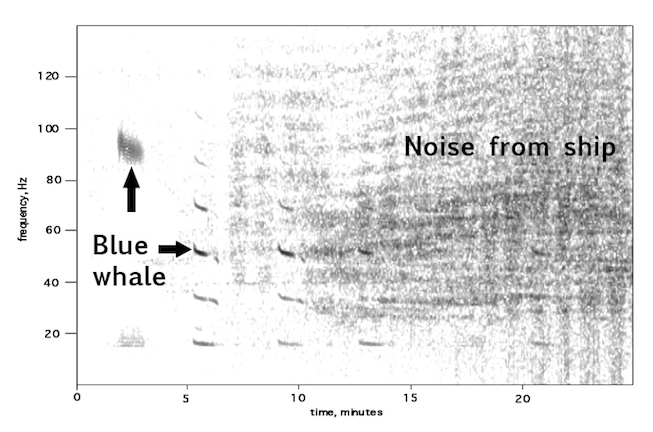
In 2014, a whale-watching group based in the mid-Atlantic Azores archipelago sent a very special blue whale photograph to Richard Sears. B105, the whale that had not been seen since 1984 in the St Lawrence and thought to have died, was very much alive and had been sighted off the coast of Pico Island. This was the first ever blue whale to have been seen on both sides of the North Atlantic. At this time the Azoreans named B105 “Invasor” due to a particular pigmentation patch reminiscent of the 1980s video game “Space Invaders”.
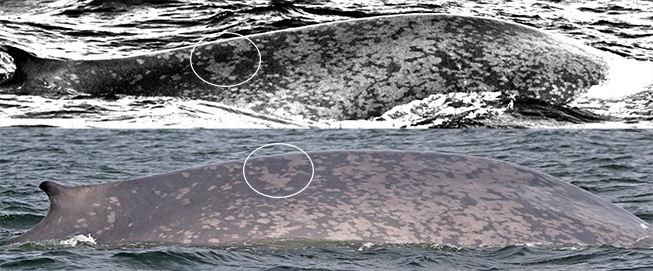
Where had Invasor been for 30 years? Is it possible that it had “fled” the noisy, increasingly busy waters of the St Lawrence where shipping has been growing? Or has it been in other habitats that we are yet unaware of?
The only certainty is that we have is that despite their massive size, we are only just beginning to understand these mysterious and elusive creatures. There is so much more to learn and so much more to do to help save these magnificent giants. A growing community of citizen scientists is joining scientists in acquiring precious information. Increasing conservation measures are being put in place in Canada and in other Atlantic countries in order to preserve this species, but there is still much to be done. Technology can be an ally in our quest to produce less noisy ships and building the picture of the blue whale’s story. As a MICS biologist myself, I feel the need to continue the work that Richard Sears started almost forty years ago, now more than ever. It is up to our generation to pick up the baton and continue the race against the oceans’ decline. As humans we may have started this trend, but we can also turn it around.
Find out more about MICS’ research and outreach on www.rorqual.com, and be sure to visit the ROM's Out of the Depths: The Blue Whale Story exhibition before it closes September 4th!
